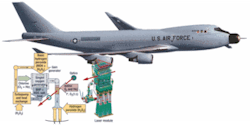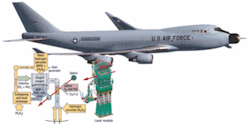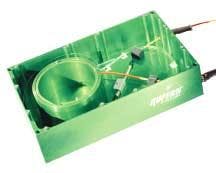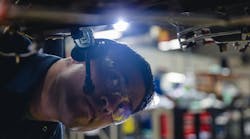KIRTLAND AIR FORCE BASE, N.M. - Last year U.S. Air Force F-16 jet fighter pilots the High-Energy Laser Fighter - better-known as the HEL Fighter - by firing the aircraft’s high-energy laser cannon at targets acquired by radar.
No, this was not Star Trek come to life but actually a computer simulation in a computerized war-game of the Air Force Research Laboratory at Kirtland Air Force Base in Albuquerque, N.M.
During the exercise, called Advanced Concepts Event or ACE, pilots used the newly developed laser-armed F-16 simulator to prepare for aerial combat once laser weapons become available. The simulator also enables Air Combat Command experts to develop tactics, techniques, and procedures for future laser battles.
“We started this effort nearly four years ago,” notes Rudy Martinez, the HEL Fighter project officer at the AFRL’s Directed Energy Directorate. “We wanted to merge an F-16 simulator with a laser weapon system so that a pilot could blend flying experience with the skills needed to operate a revolutionary speed-of-light weapon.
“A pilot would fly his F-16 differently in a laser battle compared to a more traditional fight using guns or missiles,” Martinez continues. “With guns and missiles a pilot has to maneuver to approach a target from behind or from the side. But with a laser weapon that pilot can have more latitude. That’s because the laser fires through a turret mounted underneath the plane. The turret allows the laser to fire on either side or straight ahead, so the pilot doesn’t have to do as much maneuvering.”
Improvements to HEL Fighter are in the works. One of those improvements, according to Martinez, is to use lasers, rather than radar, to acquire targets in an air battle. Until then, Martinez adds, that experience will only be available through simulators like the HEL Fighter and exercises such as ACE.
These types of laser weapons have yet to be fielded; needed, and under development, are solid-state lasers and compact electrical sources that can power high-energy laser weapons.
Today’s military is looking to deploy lasers that are invisible to the naked eye and require a large-scale design to generate enough heat to destroy targets such as missiles, says Ed Pogue, Director, High Energy Laser Joint Technology Office (HEL JTO) in Albuquerque, N.M. The weapons would also not make any noise, he adds.
The HEL JTO coordinates the Air Force, Army, and Navy’s efforts to develop high-energy laser weapons.
Weapons systems continue to appeal to the Air Force and to the U.S. Department of Defense, says Bruce Simpson, director of the AFRL Directed Energy Directorate. Most of the money - in the hundreds of millions - still goes to the U.S. Air Force Airborne Laser program, Simpson says. AFRL programs are usually in the tens of millions when it comes to funding, he adds.
We could always use more money for the right program and the right time line, Simpson says. The goal is to do things “cheaper, better, faster.”
AFRL experts are looking at three types of lasers for destroying targets: chemical lasers, solid-state lasers, and optical-fiber lasers.
Chemical lasers
The biggest laser is currently in development at the AFRL Directed Energy Directorate - the U.S. Air Force Airborne Laser (ABL), which deploys a chemical laser to destroy ballistic missiles in flight, and other targets.
The ABL attacks ballistic missiles during their boost phase, the period when they are moving on a relatively even, predictable path and, because of their pressurized fuel load, are particularly vulnerable to the ABL style of attack. The ABL system, which flies aboard a Boeing 747-400 jumbo jet, is set to shoot down its first ballistic missile in a test over the Pacific Ocean later this year.
The megawatt-class chemical oxygen- iodine laser (COIL) that will destroy ballistic missiles comes from the Northrop Grumman Space Technology division in Redondo Beach, Calif.
“The technology behind the COIL is an impressive accomplishment, probably only surpassed by the systems integration achievement on ABL,” says Jackie Gish director of directed energy technology at Northrop Grumman Space Technology.
The ABL COIL, which actually destroys the target, is a 1.5-meter-diameter laser that heats the skin of the missile, causing it to deform and resulting in internal depressurization, which causes the missile to explode, says Maj. Matt Murdough, manager of weapons system integration for the ABL at Kirtland. However, contrary to popular belief, the laser does not actually burn a hole in the missile, he adds.
The COIL-laser section is composed of six identical modules. Each module weighs roughly 4,500 pounds and is the size of a “Chevy Suburban turned on its end,” says Maj. Mark Skouson, Battle Management C4I product team leader on the ABL program at Kirtland. It is a continuous-wave laser that propagates at a wavelength of 1.315 microns, a wavelength chosen specifically because its beam travels well through the atmosphere. In other words, little of the beam’s energy is absorbed en route to the target. Iodine is its lasing medium.
The big challenge regarding the COIL laser on ABL was “integrating all the various systems onto a platform intended to operate in an airborne environment,” Gish says.
The U.S. Army’s Mobile Tactical High Energy Laser (MTHEL) is also a chemical laser. The MTHEL program is the responsibility of the SHORAD Project Office under the Army’s Program Executive Office for Air, Space, and Missile Defense. The purpose of the MTHEL program is to develop and test the first mobile directed energy weapon system capable of detecting, tracking, engaging, and defeating Rockets/Artillery/Mortars (RAM), cruise missiles, short-range ballistic missiles, and unmanned aerial vehicles. The Army is collaborating with the Israeli Ministry of Defense in the execution of the MTHEL program.
“By recently destroying mortars in-flight in August, Northrop Grumman’s high-energy laser technology continues to show its viability against current threats faced by troops in Iraq and Afghanistan,” Gish says. “The Tactical High Energy Laser test bed has shot down more than 50 threats in field tests.
“Our troops in Iraq are facing frequent mortar attacks and one challenge is to deliver systems as fast as possible,” Gish says “For MTHEL, the challenge will be to make it compact, transportable, and mobile.
“It is also a challenge to locate and track targets and place the beam on the desired location on the target,” Gish says. “MTHEL has accomplished this for the air-defense mission, but the air-to-air, air-to-ground, and shipboard missions will be more challenging, particularly to place a high-quality beam on the target through the turbulent atmosphere.”
Solid-state lasers
“Solid-state and fiber lasers offer the potential of being more compact, thus suitable to a wider range of applications and platforms,” Gish says. “Bulk solid-state lasers are more mature than fiber lasers, but fiber lasers offer the promise of higher efficiency.”
Solid-state lasers require only electrical energy to run, which makes them somewhat easier to support, Pogue says.
Northrop Grumman is one of three teams involved in the Joint High Power Solid State Laser (JHPSSL) program, which is scaling bulk solid-state lasers to 25 kilowatts.
The JHPSSL is slated to conduct laboratory demonstrations of three 25-kilowatt solid-state lasers designed by Northrop Grumman, Lawrence Livermore National Laboratory in Livermore, Calif., and Raytheon Missile Systems in Tucson, Ariz.
Right now the JHPSSL is looking at demonstrating lasers at 25 kilowatts, with 100 kilowatts obtainable in a couple years, says Michael Booen, Raytheon’s vice president of directed- energy weapons. However, these are laboratory lasers and there will be more system engineering issues to overcome before it can be deployed in the field.
“The crux of the issue with solid-state lasers is where does the power come from, how much power can be obtained, and how big a laser is needed to obtain lethality effectiveness, Booen says.
“With solid-state lasers, the challenge will be to make them more powerful and compact, and to dispose of and/or store waste heat compactly,” Gish says. “As I mentioned with ABL, systems integration will be a challenge as we strive to integrate laser defense systems on a variety of platforms.”
Typically issues boil down to efficient thermal management, Booen says. “You’re generating a tremendous amount of heat in a small spot.”
“Getting heat out of the material is one of the biggest challenges,” AFRL’s Simpson says. At this time it is “difficult and tedious to get lasers into small form factors,” and much of this is due to thermal and power issues.
“Our approach to thermal management is to remove the heat in real time,” Gish says. This allows the laser to operate indefinitely. By the way, even the heat-capacity laser removes heat from the diodes in real time.”
Fiber lasers
The push is toward using fibers for laser weapons, says Bryce Samson, vice president of business development at Nufern in East Granby, Conn. However it is not just one fiber, but also a combination of multiple fibers.
The technology is still in the research and development phase, with companies like Northrop Grumman and Hughes Research Labs in Malibu, Calif., investigating fiber-laser technology, Samson says.
Northrop Grumman’s Gish would not speculate on how long it will take before their fiber lasers are ready for military service. “The current state of the art is a kilowatt, so it will require phasing many units to get to high power. We have approaches that we believe are scalable.”
“During the past two years, the output power for single-mode ytterbium fiber lasers has increased by more than an order of magnitude, to greater than one kilowatt,” Samson says. “Beam-combining schemes have been demonstrated at lower powers, indicating feasibility for combining multiple fiber lasers to achieve 25 kilowatt or even 100 kilowatt output powers - enough power to destroy enemy missiles in flight.
“Perhaps most irresistible to those creating conceptual designs for such high-power lasers is the near-quantum-limited efficiency of ytterbium-doped fiber lasers,” Samson says. “This characteristic allows for an increase in wall-plug efficiency of greater than a factor of two versus traditional solid-state lasers - a tremendous advantage considering certain of these systems are to be flown.”
Nufern provides the fiber building blocks for this process. A company like Northrop Grumman would do the actual combining of fibers for one array, Samson says.
Looking ahead
The biggest challenge is to make the lasers reliable and affordable, says Gish. “This will occur as we move from research and development into fielding multiple systems.”
“It will be about 10 years, in 2015,” before the thermal and other issues begin to really be solved and weapons start getting fielded, says Don Seeley, Army representative at HEL JTO.
The “sweet spot” will be developing a tactical package for the warfighter in a lighter and smaller form factor, Raytheon’s Booen says. It is important to note AFRL and HEL JTO have enabled the research and development of laser weapons and shortened the time line for eventually transferring these technologies and capabilities to the warfighter, Booen adds.




